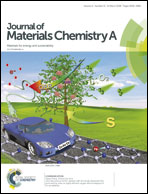A highly efficient and stable organic additive for the positive electrolyte in vanadium redox flow batteries: taurine biomolecules containing –NH2 and –SO3H functional groups†
Abstract
The vanadium redox flow battery (VRFB) is one of the most promising energy storage systems for large-scale applications. However, its commercialization has been hampered due to the low thermal stability and slow kinetics of the positive electrolyte. To solve these problems, we applied taurine and its derivatives containing both amine (–NH2) and sulfonic acid (–SO3H) groups as organic additives. Among these candidates, taurine showed the lowest overpotential and the fastest reaction kinetics, which resulted in high energy efficiency (87.9% at 50 mA cm−2) and capacity retention (87.6% after 100 cycles). Taurine was found to improve the thermal stability of the positive electrolyte by forming a vanadium–additive complex, suppressing irreversible precipitation at high temperature. Additionally, –NH2 and –SO3H groups in taurine induced nitrogen/sulfur bifunctional doping on the carbon electrode, which increased the wettability and reversibility by enhancing charge transfer and mass transport rates. Through this functional group-oriented approach that introduces taurine into the positive electrolyte, we believe that an important breakthrough has been made in VRFB technologies, which could significantly improve the VRFB performance and direct a lot of attention towards new organic additives for various redox flow batteries.



 Please wait while we load your content...
Please wait while we load your content...